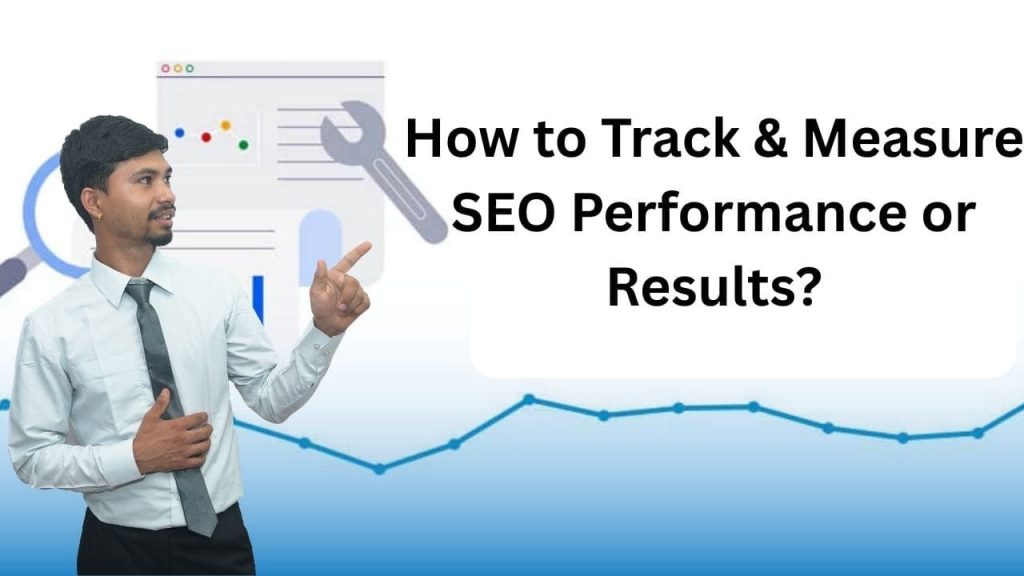Here is a simple guide that explains how to track SEO performance or results in 2025, so beginners can understand it easily.
Now, let’s get started with
What is SEO Content Performance?
SEO content performance refers to how well your SEO-optimized content ranks, attracts traffic, engages users, and drives desired actions (like conversions) in search engines like Google.
It evaluates whether your content meets both:
- Search engine requirements (ranking factors like keywords, backlinks, and technical SEO)
- User expectations (readability, relevance, usefulness,
Key Metrics to Track SEO Performance & Results
To know if your content is doing well on Google, you need to track some important numbers, also called metrics.
These tell you how many people are seeing, clicking, reading, and taking action on your blog or website.
Here are the 4 main areas to monitor SEO performance:
1. Visibility & Rankings
This shows how easily people can find your content on Google.

Keyword Rankings
This means the position of your content on Google when someone searches for a word (called a keyword). For example, if your blog is about “On-page SEO” and it appears in position 5 on Google, that’s a good keyword ranking.
- Top 3 = Very good (lots of people will click)
- Top 14 = Still good (on the first page of Google)
Impressions
This shows how many times your blog appears in search results, even if people don’t click it.
Example: If your blog showed up 500 times when people searched for something, that’s 500 impressions.
Search Visibility Score
This is like a scorecard. It tells how visible your content is overall in Google search.
- A higher score means more people can find you
- A lower score means your content is harder to find
2. Organic Traffic
This means the number of people who visit your website through Google (without clicking on ads).

Organic Clicks
This tells you how many people clicked your blog or link after seeing it on Google.
Example: 100 people saw your blog, and 10 clicked – you got 10 organic clicks.
Click-Through Rate (CTR)
CTR is the percentage of users who click on your link on a search engine results page (SERP) after seeing it, calculated as (clicks ÷ impressions) x 100%.
Example: If 100 people saw your post (100 impressions) and 10 clicked (10 clicks), your CTR is 10%.
Higher CTR means your title and description are interesting, and people want to click.
CTR Tip: Use numbers, questions, or emotional words in your titles.
Examples:
- “Content Writing For Beginners: Start With Confidence (2025)”
- “13 Content Writing Mistakes (Practical Steps To Avoid)”
Traffic Growth Over Time
This shows whether your website visitors are increasing or not every week or month.
- Growing traffic = Good SEO
- Decreasing traffic = You may need to fix or update your content
3. Engagement & User Behavior
This tells you how people behave after visiting your content.

Average Time on Page
This means how long people stay on your blog.
- If they stay for 2-3 minutes = They are reading your content
- If they leave in 10 seconds = They didn’t find it helpful or interesting
Tip: Add clear headings, images, and simple words to keep users reading.
Bounce Rate
Bounce rate shows how many people leave your website quickly after opening just one page.
- High bounce rate (above 70%) = Not good
- Low bounce rate (below 40%) = Good
Fix high bounce rate by:
- Making your content more useful
- Adding related links or videos
- Making your website mobile-friendly
Pages per Session
This refers to the number of pages a person visits on your site in one session.
Example: If someone visits your blog and clicks on your “Contact” page, they have visited 2 pages in one session.
- More pages = People are interested
- Only 1 page = Try adding more relevant links to other helpful pages
4. Conversions & Business Impact
This part checks if your content is delivering real results, such as leads, sales, or shares.

1. Lead Generation
A lead is someone who shows interest in your service.
Examples of leads:
- They fill out a contact form
- They sign up for your email list
- They ask for a free consultation
If your blog gets people to take these actions, your content is working well.
2. Sales or Revenue
If you sell something on your site, this checks if people are buying after reading your content.
Example: I write a page about “Best SEO Expert in Nepal” and someone hires me as a freelancer → That’s a sale from content!
3. Backlinks & Shares
Backlinks and shares are signals that show how valuable and trustworthy your content is.
Backlinks are links from other websites pointing to your site, which help boost your search engine ranking and authority.
Shares happen when people post your content on social media, spreading it to a wider audience and bringing in more traffic.
Together, backlinks and shares act like online “votes of confidence,” proving your content is useful and worth recommending.
Tip:
You don’t need to track everything every day. Just check these main points once or twice a month.
If you understand these simple numbers, you’ll always know how your content is doing – and what you can improve next!
Setting Clear SEO Goals
Before you start measuring anything, you need a clear goal.
Some simple SEO goals:
- Get 100 visits from Google this month
- Show up on the first page of Google for the keyword “become an SEO expert in Nepal”
- Increase the time people spend on my blogs or website
- Get 10 people to sign up for my contact form.
Free Tools You Need to Track SEO Performance
You don’t need to pay money to track your content SEO. There are free tools that give you lots of useful information.

1. Use Google Analytics (GA4)
GA4 is a free tool that analyzes:
- How many people visit your website
- How long do they stay
- Which pages do they look at
It tells you:
- What words (keywords) people typed to find your page
- How high your page appears in search results
- How many times have people clicked on your link
3. Ubersuggest (Free version)
Ubersuggest gives:
- Keyword ideas
- How many people search for a keyword
- Where your page ranks
4. RankMath (for WordPress Users)
This plugin helps you:
- Optimize content that Google and Users understand
- Use keywords in the right places
- Check if your content is easy to read
Analyzing Search Intent
Search intent means the main goal or purpose a person has when they type something into Google (or any search engine). In simple words, it’s about what the user really wants to find.
Examples:
Informational Intent → When the user wants to learn something.
Example: “Benefits of green tea” = They are looking for knowledge, facts, or explanations.Commercial Intent → When the user is comparing products or services before buying.
Example: “Best laptops under 50,000 in Nepal” = They want to explore options and reviews before deciding.Navigational Intent → When the user wants to go to a specific website or brand.
Example: “Facebook login” = They just want to reach the Facebook login page.Transactional Intent → When the user is ready to buy something.
Example: “Buy iPhone 15 online” = They are looking to make a purchase right now.
Actionable Steps to Improve Your SEO Performance

Now that you know how to track your SEO, let’s look at how to make it better.
1. Update Old Content
Check your old blogs. Add new information or update outdated facts.
2. Add Internal Links
Connect one page of your website to another page on the same site. They help users navigate easily and allow search engines to understand your site’s structure better.
3. Make Content Easy to Read
Use:
- Short paragraphs
- Bullet points
- Headings
- Images or videos
4. Improve Title & Meta Description
Your title is the first thing people see. Make it interesting!
Example: Instead of “Study Tips,” write “7 Easy Study Tips to Score Better in Exams.”
5. Promote Your Content
Share your blog on:
- Facebook
- WhatsApp groups
- Instagram
- Email, & other ways.
Conclusion
If you want your blog or website to grow, just writing content is not enough. You must track and improve your SEO performance.
Start with small steps. You don’t need to be an expert. Just keep learning, tracking, and improving. Over time, you’ll get better and your content will bring more traffic and success.
Final Tip: Don’t give up if you don’t see results right away. SEO takes time. Keep working, and your hard work will pay off.
FAQs
Here are commonly asked questions by users:
1. What is the easiest way to check if my blog is getting traffic from Google?
You can use Google Search Console to see how many people are clicking your blog from Google search. It shows clicks, impressions, and which keywords are bringing traffic.
2. How long does it take for a blog to rank on Google?
It usually takes 3 to 6 months for new content to rank, depending on how competitive the keyword is. Keep improving your content and promoting it while you wait.
3. What should I do if my blog is not ranking on Google at all?
Check these:
- Did you use the right keywords?
- Is your content helpful and easy to read?
- Are you using SEO tools like Yoast SEO (for WordPress users)?
You can also update your blog or get links from other websites.
4. Can I track SEO performance without spending money?
Yes! Tools like:
- Google Analytics
- Google Search Console
- Ubersuggest (free version)
Let you track SEO performance for free:
5. What is a good click-through rate (CTR)?
A CTR between 3% to 5% is average, but it depends on your niche. You can improve CTR by writing better titles and meta descriptions that make people want to click.



